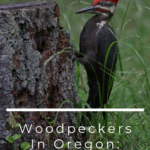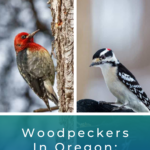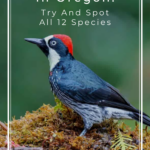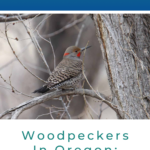Every wild west hardcore fan knows a thing or two about the State of Oregon. It has the deepest lake in the U.S. and the largest living mushroom on Earth, which is estimated to be around 8650 years old.
But Oregon is also a great attraction to wildlife lovers and birders because it boasts almost 500 species of birds.
Out of the 500 species that live in Oregon, 12 are woodpeckers, and we’ll here to tell you all about them.
Northern Flicker

- Scientific Name: Colaptes auratus
- Length: 11-14 inches
- Weight: 3-5.9 ounces
- Wingspan: 17-21 inches
The northern flicker is one of the most common woodpeckers found in Oregon. This state is home to the red-shafted northern flicker, which has red feathers on the underside of the tail and wings.
The rest of the flicker’s body is brownish gray with black markings and dots on the back and belly, respectively. This is one of the largest woodpeckers, and it’s common for males of this species to sport a red mustache.
This bird prefers to feed on the ground and horizontal branches. It has a strong barbed-tip tongue that darts out to penetrate ant colonies and eat the adult ants and larvae.
When it can’t find enough larvae, the northern flicker relies on nuts, grapes, wild berries, wild cherries, sumac, poison ivy, and sunflower seeds for food. It can also feed on moths, flies, and butterflies or, if the need to feed is strong enough, break into cow patties to feed on the insects living within.
It drums on trees or metal objects and signs when it feels threatened or wants to communicate with other woodpeckers, and it’s not uncommon to find the northern flicker near residential areas.
Downy Woodpecker

- Scientific Name: Dryobates pubescens
- Length: 5.5-7.1 inches
- Weight: 0.71-1.16 ounces
- Wingspan: 9.8-12.2 inches
There are six forests and more than 250 state parks in Oregon, and this small yet active woodpecker is a familiar face that you’re likely to see around all of them. At first glance, the downy woodpecker looks a lot like the hairy woodpecker species, but it’s slightly smaller in size and has a smaller bill-to-body ratio.
The downy has a black body and white belly, throat, and back. These woodpeckers also have small white spots on the wings, and males of this species have a bright red patch of feathers that grows at the back of the head.
In the springtime, this bird will drum on trees to communicate with others or mark its territory. If you have a bird feeder in your backyard, you may see more of this bird, especially if you fill it with suet or black oil sunflower seeds in the winter season.
It usually attracts the attention of birders due to its acrobatic flying style.
Just like other woodpeckers, this one prefers to feed on larvae, caterpillars, ants, and crop pests. However, when food is scarce, it will feed on fruit, nuts, seeds, grains, and acorns.
Pileated Woodpecker

- Scientific Name: Dryocopus pileatus
- Length: 16-19 inches
- Weight: 9-14 ounces
- Wingspan: 26-30 inches
A bird that’s almost the size of a crow, a pileated woodpecker is one of the biggest woodpeckers in Oregon and North America as a whole. The first thing you’ll see on these woodpeckers is the red crest, then you’ll notice its black body with white stripes down its neck.
The special creature serves as the inspiration for popular cartoon character Woody Woodpecker and knocks on dead trees to find carpenter ants and wood-boring beetle larvae. It leaves large rectangular holes in trees while it’s feeding, and some of them can be big and deep enough to break a small tree in half. It has a loud call and usually drums on trees to attract attention.
In forests, this species is usually attracted to larger trees for nesting and foraging. A pair will defend their territory all year round but will become more tolerant of new birds in winter.
It’s quite common to find this bird among dead trees and downed logs, so if you have dying or dead trees on your property, you might want to leave them for your friendly neighborhood pileated woodpecker. This bird will also visit your backyard in winter if you have a feeder full of suet.
Red-Breasted Sapsucker

- Scientific Name: Sphyrapicus ruber
- Length: 7.9-8.7 inches
- Weight: 1.9-2.2 ounces
- Wingspan: 14.6-16 inches
This medium-sized woodpecker’s distinctive appearance — complete with a red head and upper chest, white belly, black back, and barred wings with a large patch of white feathers — makes the red-breasted sapsucker extremely attractive to birders. Oregon is home to the northern subspecies, which is redder on the head and has less white on the back.
The red-breasted sapsucker digs wells into trees to feed on the sugary sap and the insects and larvae that get stuck inside it. The bird drills holes in neat horizontal lines and the tongue features stiff hairs to catch the flowing sap. The rufous hummingbird usually follows this bird to feed on the sap, too. It repeatedly returns to its holes to feed again, but unfortunately, these visits can eventually kill the tree.
This woodpecker relies on insects for food, too, and occasionally manages to catch them while they’re flying, which is somewhat uncommon among other woodpeckers. It’s not unusual to hear the scream-like calls of this bird near residential areas, and you’ll also hear them drumming on trees to establish their territory or attract a mate during breeding season.
Hairy Woodpecker

- Scientific Name: Leuconotopicus villosus
- Length: 7-10.2 inches
- Weight: 1.4-3.4 ounces
- Wingspan: 13-17 inches
The close resemblance between the downy and hairy woodpecker species can be a little confusing, but hairy woodpeckers have slightly larger bills and a distinctively louder call. Since both species usually occur together, it’s quite common to see downies on smaller branches and hairies on the tree trunks.
This bird has a white and black body, a mostly white belly, and black wings with white spots. Males of this species have a red patch of feathers growing at the back of their heads.
The hairy woodpecker has an erect straight-back posture and a cleanly striped head. It spends most of its time standing on tree trunks and branches, and in most cases, follows the pileated woodpecker to feed on any larvae or insects left in the holes dug by the latter. This bird also likes to lick the sap from the sap wells dug by various sapsuckers and eat moth pupae and other larvae that get attracted to the sap.
While the hairy woodpecker usually prefers to build a nest in a dead tree, it can also be found in a living tree if it’s infected with heart rot. When it excavates a nest, the bird will keep the entrance to the underside to protect the eggs and small birds from flying squirrels and other predators.
Acorn Woodpecker

- Scientific Name: Melanerpes formicivorus
- Length: 7.5-9.1 inches
- Weight: 2.3-3.2 ounces
- Wingspan: 13.8-16.9 inches
If you ever hear a loud, weird laugh in the middle of oak woodlands in Oregon, chances are there is an acorn woodpecker nearby.
This medium-sized bird is special in appearance with wide, clown-like eyes, an almost black body, and a white throat, belly, and forehead. Male birds have a red patch on the forehead, and female birds have a small black spot between the forehead and the cap.
Acorn woodpeckers’ nesting areas are dead parts of big trees, and they store thousands of acorns into the holes they dig. Multiple males and females guard the nest, and there’s always a group member who watches the surroundings to alert other birds in case of danger or a thief tries to steal the stored acorns. This woodpecker species’ cooperative behavior is probably due to the bird’s limited territories.
As indicated by its name, this fascinating creature prefers to munch on the acorns it tucks away in cavities in dead wood, but in some cases, the bird will also feed on insects, sap, nuts, and fruit.
If you’ve got a feeder filled with seeds and suet, you can count on a visit from this bird, but be warned: if it starts digging into your wood siding, it will be quite difficult to get rid of.
Lewis’s Woodpecker

- Scientific Name: Melanerpes lewis
- Length: 10.2-11 inches
- Weight: 3.1-4.9 ounces
- Wingspan: 19.3-20.5 inches
Meet Lewis’s woodpecker. This particular species, named after Meriwether Lewis of the famed Lewis and Clark duo, makes its home in Oregon year-round, but only in the trees within the white-oak ponderosa pine belt.
They may be woodpeckers, but these creatures rarely dig into trees to find wood-boring insects. Instead, it’s more common for them to forage like flycatchers. They stay on high alert, waiting for their food to fly through the air before taking flight to catch it.
Its appearance makes this bird special; with its back decked out in dark green feathers, a pink belly, and gray neck, it looks unlike any other.
Williamson’s Sapsucker

- Scientific Name: Sphyrapicus thyroideus
- Length: 8.3-9.8 inches
- Weight: 1.6-1.9 ounces
- Wingspan: 17 inches
The Williamson’s sapsucker gets its name from its tendency to drill shallow holes in trees to suck out the sweet, sticky liquid and from engineer and army colonel, Robert Stockton Williamson.
Males and females look so different that when they were first discovered, ornithologists had no idea they were the same species! Their confusion makes sense, however, as the male has a red throat, yellow belly, and white patches on his wings while the females have brown heads, banded backs, and black and yellow bellies.
In the summer, look for them in mature forests, using their medium-sized bill to drill holes in coniferous trees to suck the sap out. When winter rolls around, these woodpeckers move to pine woodlands.
When they’re not drilling sap wells, Williamson’s bird makes a meal of insects found in trees, on the ground, or caught mid-air. It’s not uncommon for this bird to snack on berries, as well.
Red-Naped Sapsucker
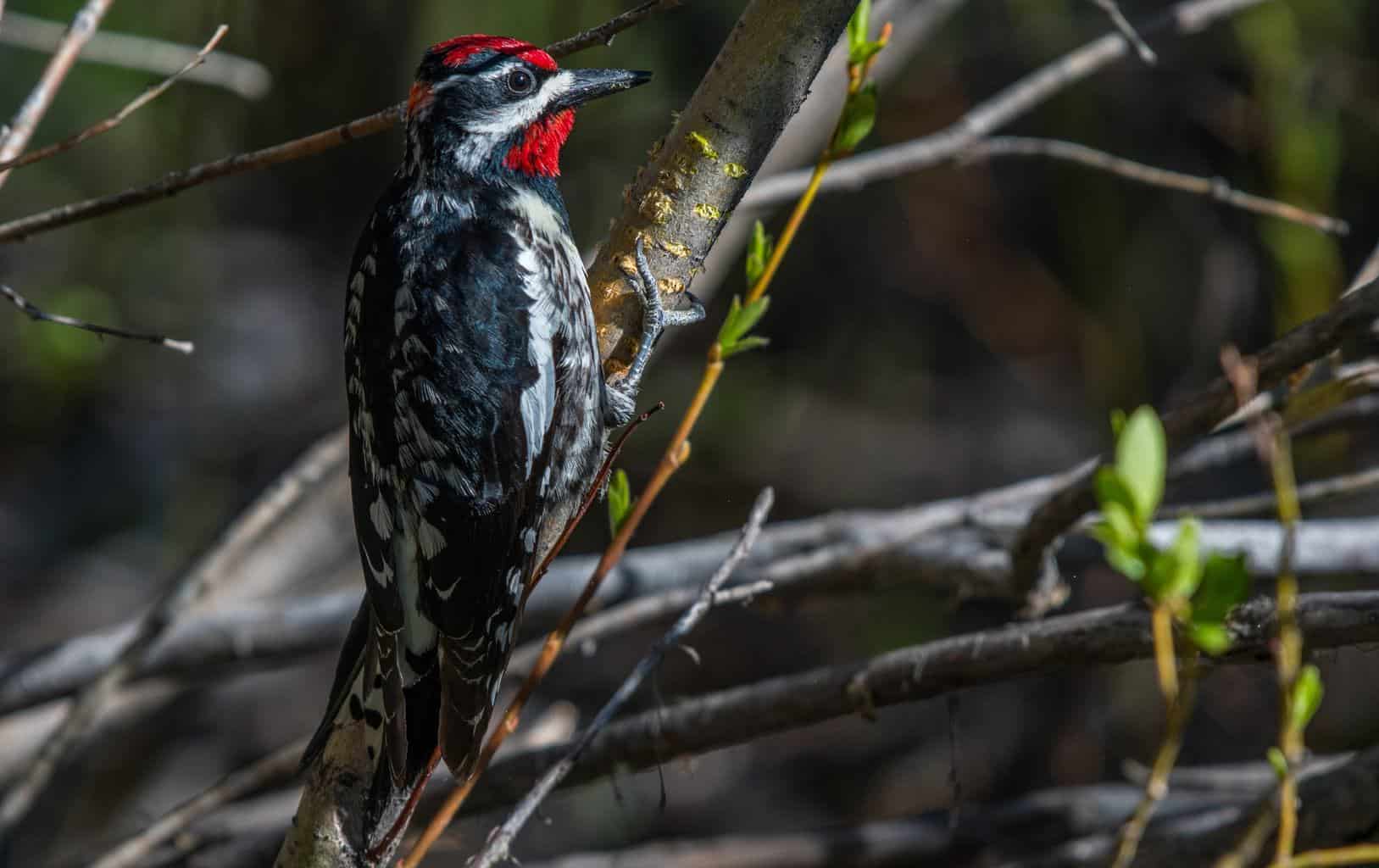
- Scientific Name: Sphyrapicus nuchalis
- Length: 7.5-8.3 inches
- Weight: 1.1-2.3 ounces
- Wingspan: 16.1-16.9 inches
Just like the rest of its sapsucker cousins, this bird uses its bill to drill holes in aspen, birch, and willow trees to sip on the sweet, sugary sap that flows out.
The red-naped sapsucker is a medium-sized bird, slightly larger than a downy but smaller than the northern flicker. Identify it by its crimson nape, throat, and cap, as well as the long white bar on its wing and a black stripe through its eye. Females of this species sport a patch of white on their chins while males’ are entirely red.
If you can’t identify this sapsucker by its appearance, listen carefully; it’s not uncommon to hear these woodpeckers drumming away in the woods; they have a very distinct, stuttering drumming pattern.
White-Headed Woodpecker
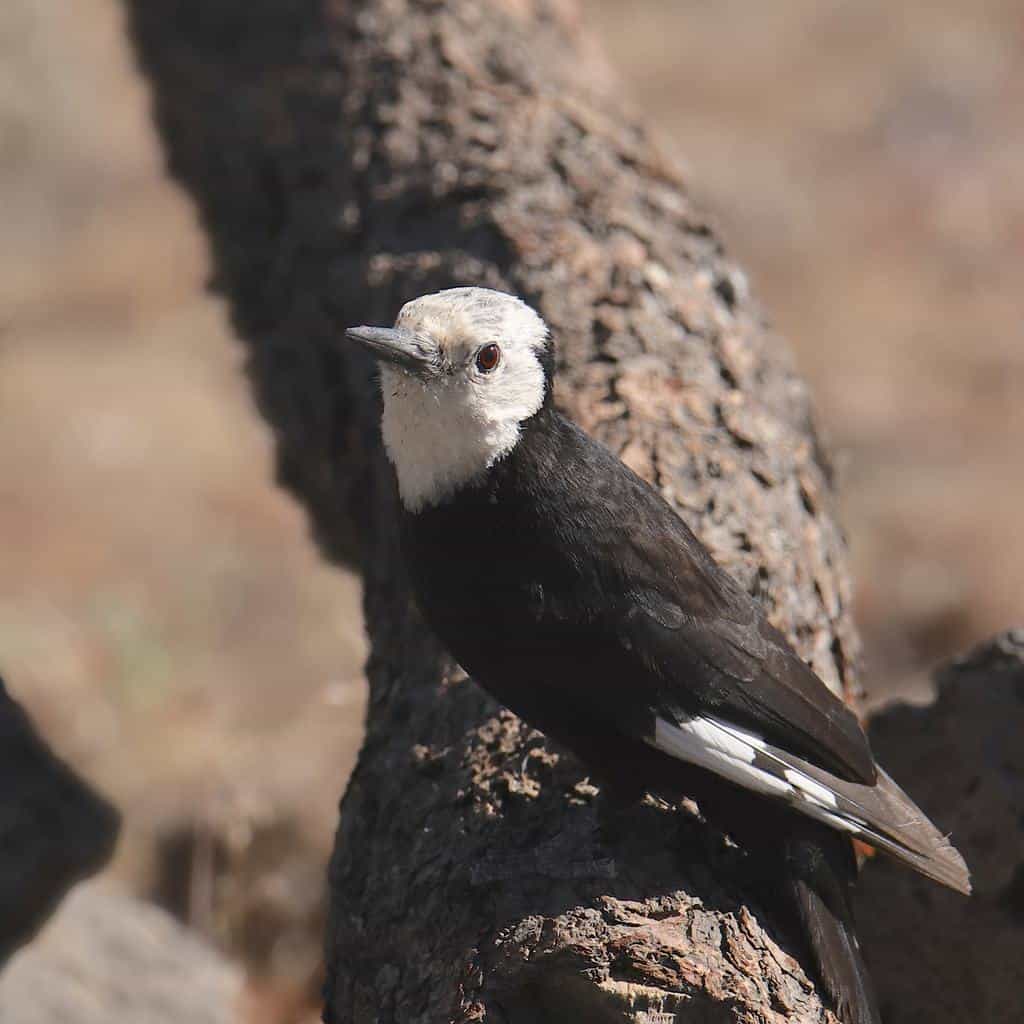
- Scientific Name: Dryobates albolarvatus
- Length: 8.3-9.1 inches
- Weight: 1.9-2.3 ounces
- Wingspan: 17 inches
Based on its name, you’d probably assume the white-headed woodpecker’s head is covered in white feathers, and you would be absolutely correct. This bird is mostly black, except for a white head and bases to its primary feathers. Males and youths of this species have red crowns.
These creatures reside in the northwestern region of North America, including Oregon and British Columbia, year-round and can be found in mountain forests where pine is abundant.
These woodpeckers are quite unusual; instead of drilling into wood to dig around for bugs and insects, they use their bills to flake away bark and probe pine needle clusters to find food.
When it comes to nesting and breeding, both the male and female white-headed woodpecker incubate the eggs and use soft drumming to communicate with each other from in and outside of the nest cavity.
American Three-Toed Woodpecker

- Scientific Name: Picoides dorsalis
- Length: 8.3-9.1 inches
- Weight: 1.6-2.4 ounces
- Wingspan: 14.6-15.3 inches
The American three-toed woodpecker is a small bird that makes its home in the mountain areas of western North America. Because they’re relatively quiet, it’s easy to overlook our three-toed friend, but if you’re in a forest area that’s been recently burned or attacked by bark beetles, keep your eyes peeled; you’ll probably see one or two.
Despite its petite size, the American three-toed woodpecker packs a powerful punch. This is because of the evolutionary loss of the fourth toe that allows the species to lean farther away from the trees, gain more momentum, and hit the wood harder than other woodpeckers.
Much like the species listed above, this three-toed bird rarely digs deep into the wood to find food; instead, it uses its chisel-like bill to flake away bits of bark to eat what’s underneath.
Black-Backed Woodpecker
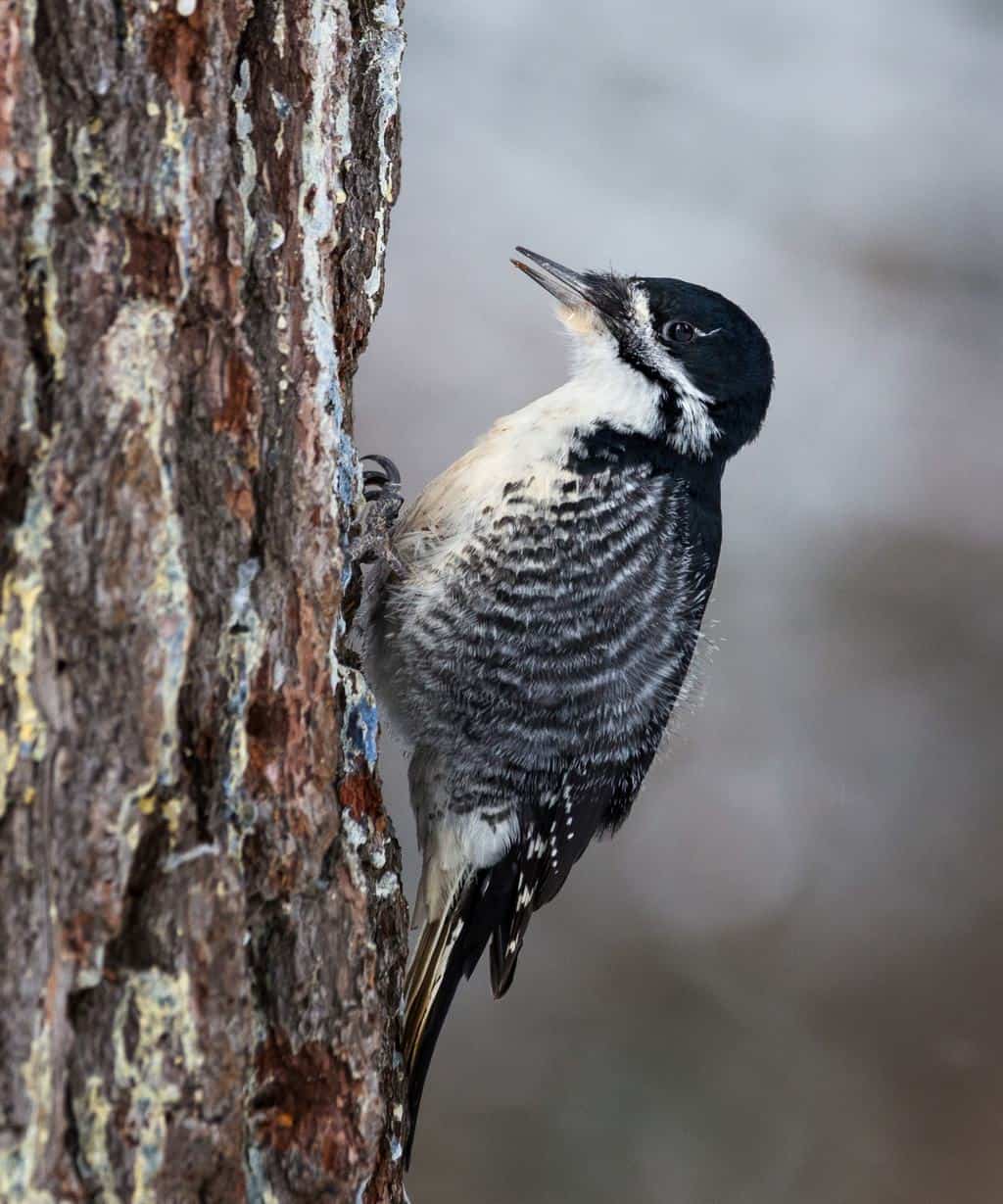
- Scientific Name: Picoides arcticus
- Length: 9.1 inches
- Weight: 2.1-3.1 ounces
- Wingspan: 15.8-16.5 inches
While they look somewhat similar and can generally be found in the same habitat as the American three-toed woodpecker, don’t get these two confused. In fact, whenever these two are around each other, the black-backed bird, also known as the Arctic three-toed woodpecker, is dominant and drives its sister species away from nesting and feeding areas.
Because it only boasts three toes, the black-backed woodpecker packs a powerful punch as well, leaning back farther and hitting trees harder than any of the four-toed woodpeckers it shares the forest with.
This bird has a large black head that sports a single white mustache stripe and a dot above the eye. The male wears a yellow crown patch.
Find these birds in recently burned forests. They like to spend a long period of time excavating in one spot, making sure they get every wood-boring beetle larvae out of the tree. In fact, once they scout out a burned forest, it’s common for the black-backed bird to feed in the area for up to eight years!
Conclusion
If you find yourself in one of Oregon’s forests (which make up almost 48.1 percent of the state, by the way), like the Willamette National Forest, make sure you’ve got your eyes wide open and a bird field guide in hand; you’re sure to spot one or more of these woodpecker species.
And if treks through the forest aren’t your thing, woodpeckers are usually attracted to feeders that are filled with suet, nuts, and seeds, so consider setting one up in your backyard if you want to bring them to you instead.


